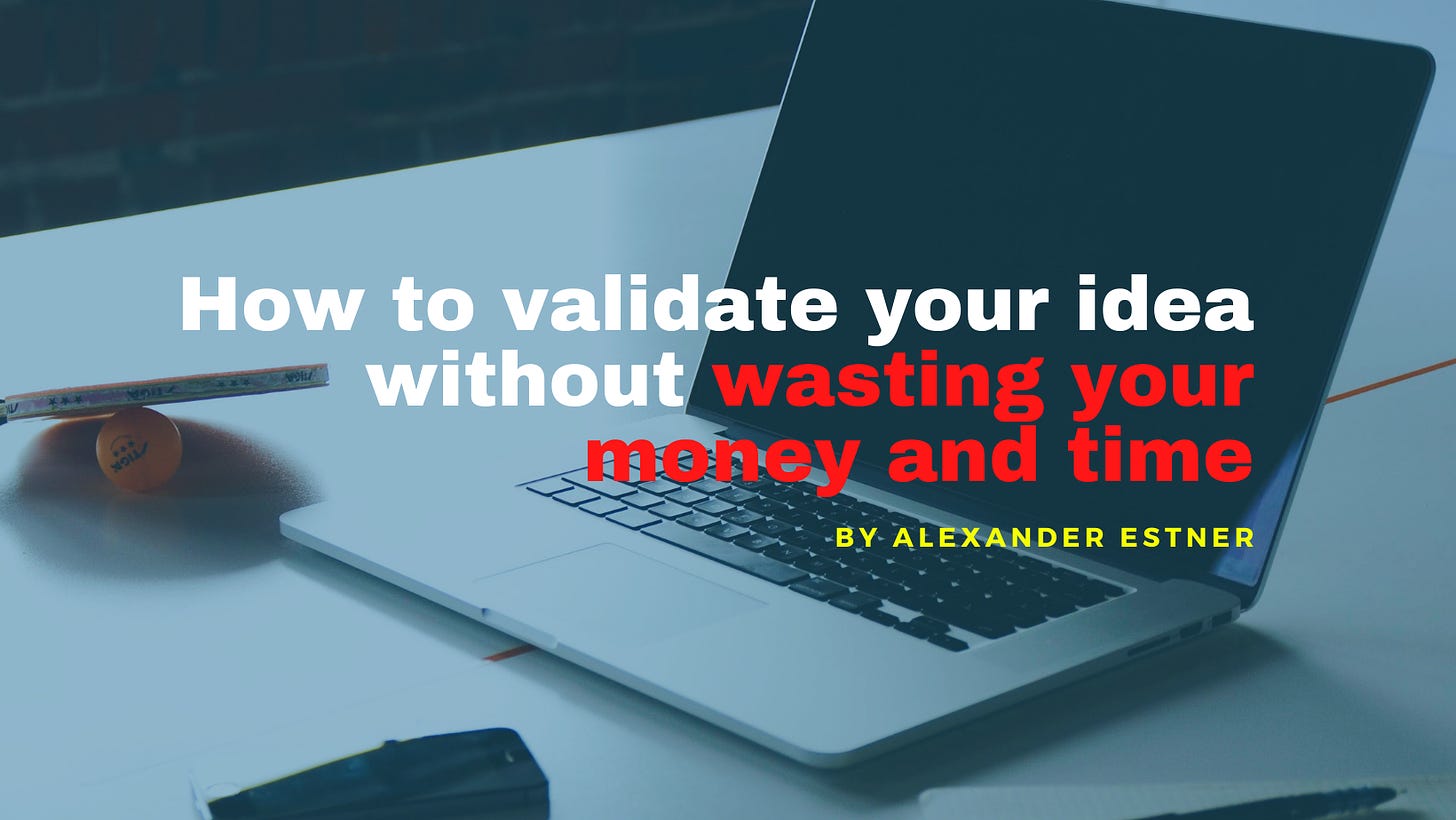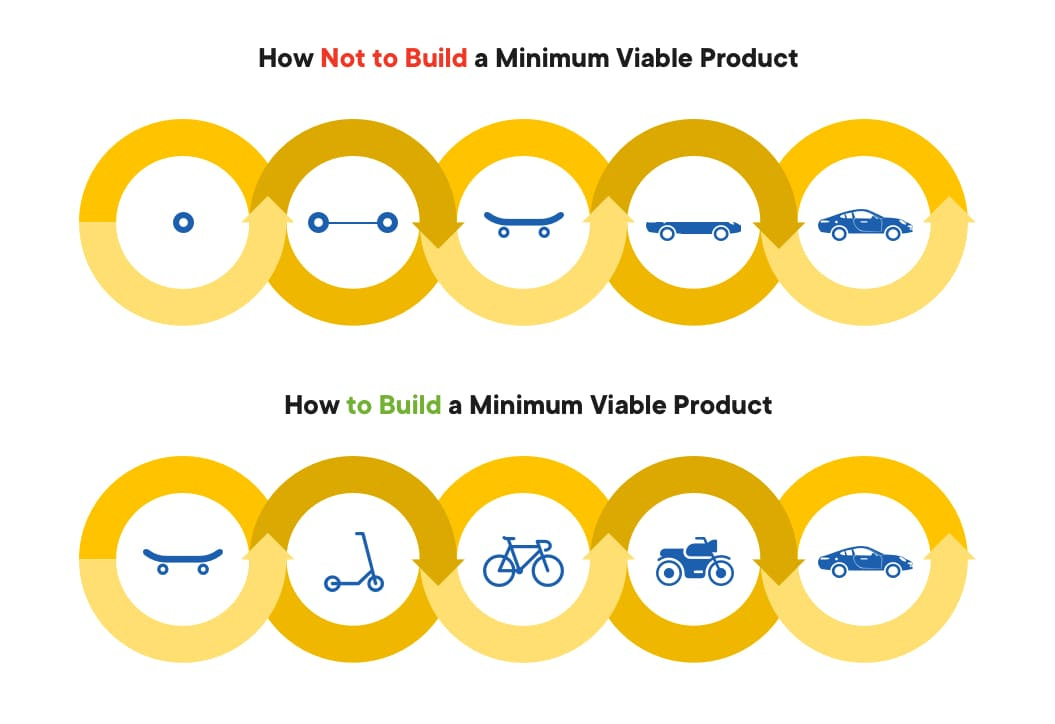In today's article, we will cover the topic of how you can validate your business idea BEFORE you start building your product and wasting lots of time and money.
Validating your business idea means, determining if there is a (big enough) need for your product in a specific market (your target customers), as well as whether people are willing to pay to have that need met.
Why should you validate your business idea before building the product
One of the most common and painful mistakes you can make as an early-stage founder is having a (great) idea and immediately spending all your time building a product without validating the idea upfront. Validating your idea brings the following advantages:
minimize your risk of building a product nobody needs or wants to buy
don't waste your time and money
predict the revenue potential f your business idea upfront
speeds up your delivery of a highly valuable product (later on)
Different ways to validate
Probably the truest and most reliable way to validate your business idea is that people actually give you money. That's also the reason why lots of startups build landing pages with checkout pages (payment gateways) and ask customers to pay for their planned product - even if there is no product available yet.
Here's a shortlist of validation strategies, starting with the easiest (which also tend to be low-confidence) and moving to the hardest (high-confidence):
gather data based on market research (e.g. Search interests like Google trends, SWOT Analysis, Market Trends, Papers, Statistics, Reviews, Communities like Facebook Groups or Reddit,...)
market testing by talking to other people/stakeholders (e.g. interviews, surveys, polls,...)
get real market commitment (waitlists, sales, letter of intent, pre-orders/crowdfunding, beta-tester)
I can highly recommend the book The Mom Test by @robfitz
5 Steps to Validate your Idea
Step 1: Write down core assumptions and hypotheses
The first step to validating your business idea is to write down the key assumptions for your business.
An assumption is something that you believe about your customer, market, and your product without any significant evidence.
A hypothesis is your personal best guess about what you expect to happen in a given experiment. It's important that you phrase your hypotheses in such a way, that you run the experiment, measure the result/metric, and take a conclusion (verified or rejected). A useful hypothesis is a testable statement.
Preferably your hypotheses follow a cause and effect structure with a measurable goal, e.g. 'If I write weekly valuable content for my subscribers, 30% of them will share the content with others.'
By the way 😜 : If you like the content, share it with your friends and help me to achieve my goal of 3000 subscribers.
Those core assumptions about your business help you to come up with hypotheses that you are going to test and verify in the next steps.
I would limit the number of core hypotheses to a maximum of 25. Otherwise, you are losing the overview.
Step 2: Rank your hypotheses (hypothesis score)
To know where to start testing your hypotheses, I would highly recommend defining for each of your hypotheses 2 metrics:
impact on your business (on a scale of 1 to 10)
uncertainty (on a scale of 1 to 10)
Multiply both metrics, you will have your hypothesis score. Now, rank the hypotheses based on their individual hypothesis score. Focus your energies on what really matters and validate the important hypotheses first.
Startup Business Tips - Hypotheses Validation Framework
Step 3: Research the market (size)
After you've phrased your core hypotheses, spend some time researching the market and your potential opportunity. Find answers to the following questions:
How big is the market?
Is the market growing?
What is the growth rate of this market?
How many relevant competitors are in this market?
How many people are searching for your product or the problem you are trying to solve?
How much money do people spend on average on your product?
Are there any significant user behavior changes/trends for your business (e.g. online payment share, vegetarians, online advertisement spend...)?
Based on your research, do the first calculation on the market size and your revenue potential. Here is a theoretical example: You want to serve vegetarian restaurants with a new software product, I would do the following quick calculation:
11 million restaurants in Europe
share of vegetarian restaurants is 3%, assuming to grow to 8% in the next 10 years
this means a TAM of 880k vegetarian restaurants
planned SaaS price of 100€/month means a TAM of 88 million € per month
potential to win a market share of 10% of the TAM, which means 8.8 million € per month revenue potential
Step 4: Market testing with customer interviews
To avoid the mistake of building a product no one needs, talk early to your customers. For me, this step is probably the most important step in your validation.
Spend enough time with your customers and really understand their challenges, problems, and needs. If you find out about their biggest problems (pain points) and you are building a product or service that solves their biggest problems, you can almost be sure they are willing to pay for it.
Great questions to ask potential customers include:
What are the 3 most annoying/biggest problems for you in terms of...(fill in the product category, the market you are after)?
How are you currently trying to solve…(Fill in the problem)?
What’s the most annoying thing about the...(Fill in the problem you are trying to solve)?
Why didn’t you already change it? What's holding you back to solve the problem?
How would the ideal world be for you?
I am working on...(Fill in your solution)- Would that be valuable to you? Why? Why not?
Make sure you first understand your customer's needs and motivation before talking about your idea. Don't try to lead the conversation to your solution. This will help you get the most out of customer interviews.
Step 5: Run experiments around your hypotheses
Now it's time to do quick experiments and test your hypotheses. Depending on the types of hypotheses you can use different ways to validate your hypotheses. Use the hypotheses validation framework to run your own experiments.
Always think about ways how you can test the hypotheses really fast and cheaply (without spending time and money on actually building the product).
Popular types of MVPs are:
'Concierge' or service MVP
This means instead of actually building the product, you offer your manpower/human resources to solve your customers' needs. E.g. if you are building marketing software to automatically optimize Facebook ads, you can start to do Facebook ads optimization as a service.
This approach allows you to test your idea without developing any product.
Landing Pages (with sign-ups and waitlists)
You can create a landing page describing your planned product and the problem you are trying to solve. Landing pages are great to test your hypotheses against user expectations and interests. Offer visitors a call to action which helps you to measure your idea, popular CTAs are:
email sign-ups
waitlist sign-ups
actual checkout/payments
schedule demos
Physical prototype
If you are building a physical product, test and evaluate your potential solution by building a low fidelity physical prototype for customers to interact with.
Pre-sales
Talk to your customers in person and test their interest and willingness to pre-order. Also great in combination with a landing page.
Crowdfunding and Product Hunt
Another strategy is to test the interest of potential customers using crowdfunding platforms or platforms like https://www.producthunt.com/ to promote your business idea. This strategy needs to be combined with one of the MVP types above.
I really like this image on how to build a minimum viable product (MVP).
I can highly recommend checking out Dan Federiko's article on How to build an MVP.
Measuring success
Make sure you always measure the performance of your MVPs (and experiments). Define up front what a successful MVP looks like (success metric) for you and write it down. For instance, a successful MVP could be defined as follows:
a waitlist of #100 B2B customers
pre-orders of #1000 units
20% of all interviewed companies signed a letter of intent
a conversion rate of 5% for visitors to sign up
If you have proven your hypotheses and gained (enough) confidence in your business idea, it's finally time for you to build your amazing product.
Grow your business with a powerful strategy
Don’t forget to download your FREE copy of the SaaS Growth Strategy Worksheet.
References: This article is inspired by Syed Hemu Rahman (My Playbook for Building and Launching a Startup in 30 Days), Dan Fedirko (How to build MVP [step by step guide]), Alex Chuang (The Ultimate Step-By-Step Guide to Validating Your Startup Idea), Amit Machanda (A Step-by-Step Guide to Build a Minimum Viable Product (MVP)), and Kevin Hall (How to Evaluate Startup Ideas).
Also, check out:
🚀 3 more things
If you need support in growing your B2B SaaS business, feel free to reach out to me via Linkedin.
Do you want more content? Check out some more helpful resources and subscribe to my FREE bi-weekly Newsletter on Substack.
Give back time: If you like the content, give it a like and leave a comment below. Simply share the newsletter with others and help me to reach my goal of 3000 subscribers.






It's critical to validate an idea before launching a product. In the end, the product matters if it solves a problem and brings value. I liked your graphic representation of how to build a minimum viable product. However, some readers will want to learn more about building an MVP. For that reason, I will provide additional info https://solveit.dev/blog/guide-mvp-development. I liked that guide because it shows all you need to know on how to build MVP in 2023.